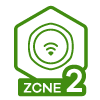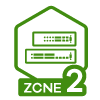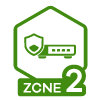Clarification regarding LAN1 port of NWA210AX
 Freshman Member
Freshman Member


So I'm reading this about the LAN1 port of my NWA210AX:
My question is: are both ports (LAN1 and Uplink) bridged together or does the NWA210AX have an internal switch for these two ports? Bridging and switching are two completely different things, as you know.
Best Answers
-
The behavior of LAN1 and Uplink on the NWA210AX depends on your configuration. When VLANs are not specifically configured on the LAN port, LAN1 and Uplink are indeed bridged together. However, if you configure different VLANs for the LAN port, it can belong to multiple VLAN groups simultaneously, resembling a switching behavior.
In summary:
- Without VLAN Configuration: LAN1 and Uplink are bridged together.
- With VLAN Configuration: The LAN port can belong to different VLAN groups, exhibiting switching-like behavior.
Kay
0 -
The AP LAN port settings are aligned with the VLAN configuration on the switch. To achieve the desired functionality, you should set the LAN port's PVID (Port VLAN ID), specify allowed VLANs, and configure TX tagging as needed. Here are reference instructions for both standalone mode and Nebula Cloud mode:
- In Standalone mode
You may configure the LAN PVID, allowed VLANs, and TX tagging at CONFIGURATION > Network > VLAN > LAN Setting - In Nebula Cloud Mode
You may configure the AP LAN PVID and allowed VLANs at Site-wide > Configure > Access points > AP & port settings > Port setting.
By setting the PVID, the port is automatically designated as an untagged member of the specified VLAN in the background.
Kay
0 - In Standalone mode
All Replies
-
The behavior of LAN1 and Uplink on the NWA210AX depends on your configuration. When VLANs are not specifically configured on the LAN port, LAN1 and Uplink are indeed bridged together. However, if you configure different VLANs for the LAN port, it can belong to multiple VLAN groups simultaneously, resembling a switching behavior.
In summary:
- Without VLAN Configuration: LAN1 and Uplink are bridged together.
- With VLAN Configuration: The LAN port can belong to different VLAN groups, exhibiting switching-like behavior.
Kay
0 -
Right. But physically, both ports are wired together as pass-through, yeah?
0 -
As mentioned earlier, the behavior of LAN1 and Uplink ports on the access point depends on how you've configured them. Generally, the uplink port is designed for transmitting outgoing data to a router or other uplink network devices, while the LAN1 port is intended for communication with AP clients, including PCs, other switches, and similar devices.
To offer you more precise assistance, could you please share additional details about your specific usage or configuration? This additional information will allow us to gain a deeper understanding of your requirements and provide you with the most relevant guidance.
Thank you!
Kay
0 -
Look, I completely understand what you're saying. But my question is about how they are physically wired regardless of the config.
If they are physically wired like a switch, both ports are independent of each other. The uplink port can be a trunk/tagged port received multiple tagged packets and the lan1 port can be configured as an untagged port or another tagged/trunk port, just how a regular managed switch works.
But if they are wired as a bridge, if the uplink port is receiveing multiple tagged packets, then that will just carry over to the lan1 port.
My setup is simple. Main switch to AP (using the uplink port) and the AP to another switch (using the lan1 port). I'm assuming both ports are bridged, so the 2nd switch should also be configured so that the AP port is tagged/trunk.
0 -
The AP LAN port settings are aligned with the VLAN configuration on the switch. To achieve the desired functionality, you should set the LAN port's PVID (Port VLAN ID), specify allowed VLANs, and configure TX tagging as needed. Here are reference instructions for both standalone mode and Nebula Cloud mode:
- In Standalone mode
You may configure the LAN PVID, allowed VLANs, and TX tagging at CONFIGURATION > Network > VLAN > LAN Setting - In Nebula Cloud Mode
You may configure the AP LAN PVID and allowed VLANs at Site-wide > Configure > Access points > AP & port settings > Port setting.
By setting the PVID, the port is automatically designated as an untagged member of the specified VLAN in the background.
Kay
0 - In Standalone mode
-
Ok, so PVID is the native VLAN for that port? And the allowed VLANs are the tagged VLANs for that port?
0 -
Yes, you may say that.
Kay
0 -
Can you assign a set of allowed VLANs on the uplink port that's different from the set of allowed VLANs on the lan1 port?
0 -
For the uplink port of the access point, you cannot directly set the allowed VLANs. Instead, you should configure the allowed VLANs on your main switch, which is connected to the AP's uplink port. The VLAN configuration for the uplink port should be handled on the upstream switch to control which VLANs are allowed on the network segment connected to the AP's uplink port.
Kay
0
Categories
- All Categories
- 441 Beta Program
- 2.9K Nebula
- 208 Nebula Ideas
- 127 Nebula Status and Incidents
- 6.4K Security
- 528 USG FLEX H Series
- 331 Security Ideas
- 1.7K Switch
- 84 Switch Ideas
- 1.3K Wireless
- 50 Wireless Ideas
- 6.9K Consumer Product
- 292 Service & License
- 462 News and Release
- 90 Security Advisories
- 31 Education Center
- 10 [Campaign] Zyxel Network Detective
- 4.7K FAQ
- 34 Documents
- 86 About Community
- 99 Security Highlight
 Zyxel Employee
Zyxel Employee








